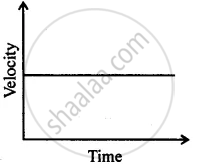Advertisements
Advertisements
प्रश्न
An object starting from rest travels 20 m in the first 2 s and 160 m in the next 4 s. What will be the velocity after 7 s from the start?
उत्तर
For first 2 s motion of object,
u = 0, f = 2 s, s = 20 m
Using s = `"ut" + 1/2 "at"^2`
we got 20 = `0 + 1/2 "a" xx 2^2`
or a = 10 ms−2
Velocity attained by object at the end of 2s
v = u + at
= 0 + 10 × 2
= 20 ms−1
For next 4s, journey of object,
t' = 4s, u' = 20 ms−1, s' = 160 m
∴ s' = `"u'""t'" + 1/2 "a'""t'"^2`
⇒ 160 = `20 xx 4 + 1/2 xx "a'" xx 4^2`
or 8a' = 80 or a' = 10 ms−2
It implies that acceleration is uniform throughout the journey.
∴ velocity after 7s from start, v = u + at
= 0 + 10 × 7
= 70 ms−1
APPEARS IN
संबंधित प्रश्न
Find the initial velocity of a car which is stopped in 10 seconds by applying brakes. The retardation due to brakes is 2.5 m/s2.
A cheetah starts from, rest, and accelerates at 2 m/s2 for 10 seconds. Calculate :
(a) the final velocity
(b) the distance travelled.
Give one example of following motion :
Variable acceleration
State how the velocity-time graph can be used to find
The acceleration of a body
What do you understand by the term acceleration?
When is the positive acceleration?
Multiple choice Question. Select the correct option.
A body dropped from the top of a tower reaches the ground in 4s. Height of the tower is
Can you suggest a real-life example about the motion of a body from the following velocity – time graph?

A stone thrown vertically upwards takes 3 s to attain maximum height. Calculate
- initial velocity of the stone
- maximum height attained by the stone. (Take g = 9.8 ms−2)
The velocity-time graph (Fig. 8.5) shows the motion of a cyclist. Find (i) its acceleration (ii) its velocity and (iii) the distance covered by the cyclist in 15 seconds.

